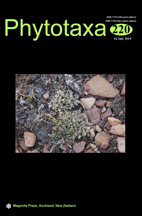Abstract
Peridinium acuminatum (Peridiniales, Dinophyceae) was described in the first half of the 19th century, but the name has been rarely adopted since then. It was used as type of Goniodoma, Heteraulacus and Yesevius, providing various sources of nomenclatural and taxonomic confusion. Particularly, several early authors emphasised that the organisms investigated by C.G. Ehrenberg and S.F.N.R. von Stein were not conspecific, but did not perform the necessary taxonomic conclusions. The holotype of P. acuminatum is an illustration dating back to 1834, which makes the determination of the species ambiguous. We collected, isolated, and cultivated Scrippsiella acuminata, comb. nov. (strain GeoB 427) from the type locality off Kiel, Germany (Baltic Sea). We barcoded the species of the Thoracosphaeraceae using rRNA sequences and investigated the morphology of the strain using light and electron microscopy. As taxonomic result, we designate an epitype for Peridinium acuminatum, as no conflict with C.G. Ehrenberg’s protologue can be stated. It is indistinguishable from Scrippsiella trochoidea (likewise described from the Kiel Fjord) that we consider a later heterotypic synonym. Our study contributes to the disentanglement of dinophyte taxonomy in a very challenging case, and we trust that C.G. Ehrenberg and S.F.N.R. von Stein investigated different species under the epithet ‘acuminatum’. The complex nomenclature and taxonomy of Goniodoma, and its type species Goniodoma acuminatum, is discussed in the Electronic Supplement. We consider Pyrrhotriadinium, with the type species Pyrrhotriadinium polyedricum (Gonyaulacales), well suited to harbour all gonyaulacalean taxa so far assigned to Goniodoma and Heteraulacus as well.

